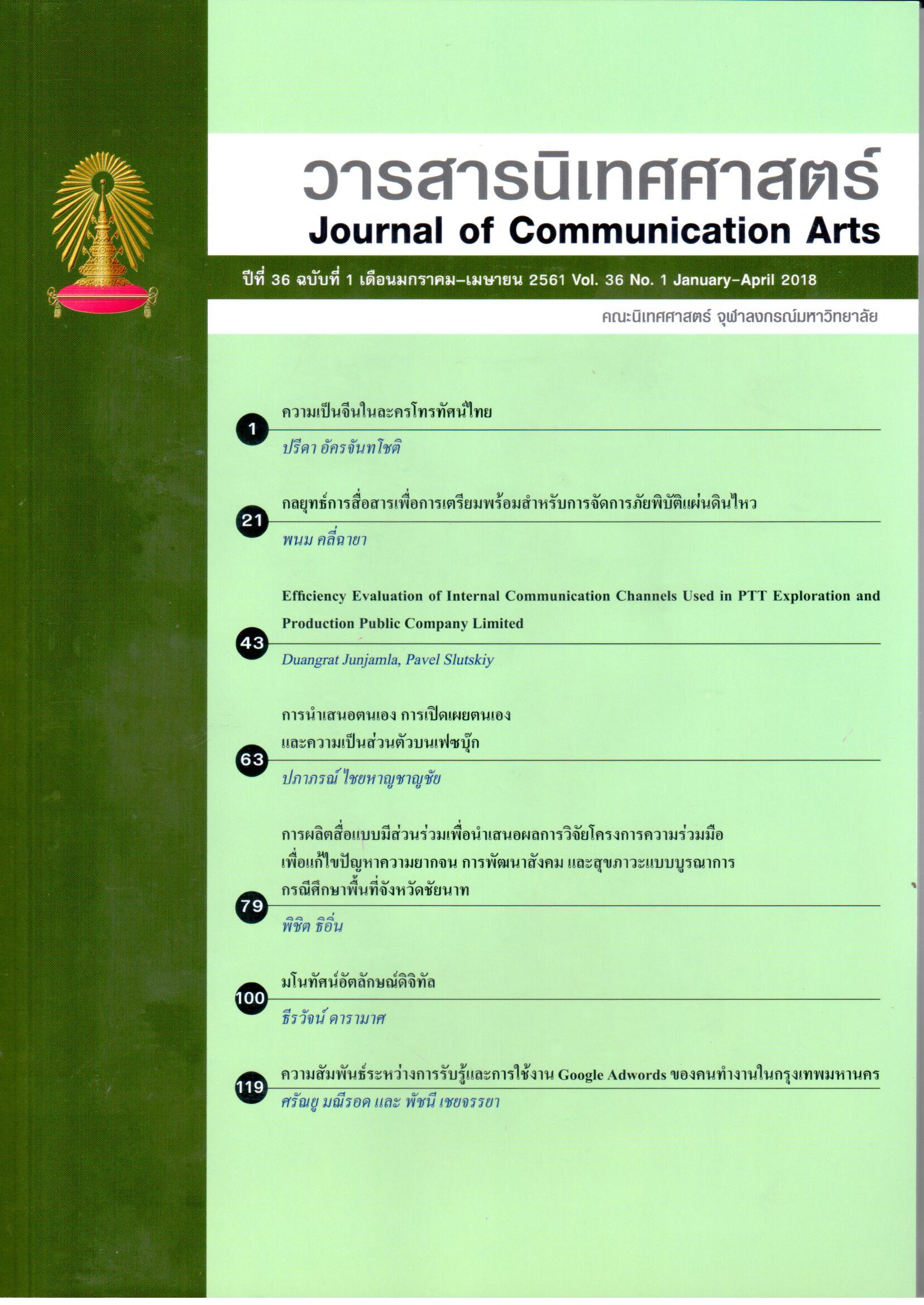กลยุทธ์การสื่อสารเพื่อการเตรียมพร้อมสำหรับการจัดการภัยพิบัติแผ่นดินไหว
Main Article Content
Abstract
The communication strategy scheme for disaster management is the output of research title “Communication Strategy for Earthquake Disaster Preparedness”. The research explore people’s perception on earthquake, describe community factors involved with earthquake disaster and develop communication strategy for earthquake disaster preparation. The communication strategy scheme divided into 3 phases, include before, during and recover phase.
- The before event strategy - the phase of before earthquake happening. In this phase communication focuses on prevention, preparing and developing roles. The research suggests 4 ways of communication: 1) Communication to create network for preparedness with stakeholders; community, media, government officers and scientists; 2) Communication campaign for education and reinforcement of desired attitude and practice both in community and national levels; 3) Communication supporting disaster management plan implementation; and 4) Established earthquake media channels.
- The initial and during event strategy - the phase of while earthquake taking place. In this phase, communication is utilized for emergency response. The communication strategy emphasizes on news report and information management to control people panic and mobilize all resources to rescue victims.
- The recovery phase strategy - the phase of after earthquake completing. In this phase, communication is used to heal anxiety of victims stress, and to support the disaster management plan improvement. The communication strategies emphasize on using participatory communication in community for recovery and advocating public policy for disaster management improvement.
Article Details
Section
Articles
References
ภาษาไทย
ทวิดา กมลเวชช. (2554). คู่มือการจัดการภัยพิบัติท้องถิ่น. กรุงเทพมหานคร. บริษัทธรรมดาเพรส จำกัด.
พนม คลี่ฉายา. (2559). กลยุทธ์การสื่อสารเพื่อการเตรียมพร้อมสำหรับการจัดการภัยพิบัตแผ่นดินไหว. รายงานการวิจัย กองทุนรัชดาภิเษกสมโภช จุฬาลงกรณ์มหาวิทยาลัย, (CU-59-059-CC)
รัชนี ประดับ. (2554). ขบวนชุมชนจังหวัดน่านกับบทเรียนภัยพิบัติในปี พ.ศ. ๒๕๕๔. เอกสารประกอบการสัมมนา. พลังชุมชนท้องถิ่น จัดการภัยพิบัติอย่างยั่งยืน. วิสคอมเซ็นเตอร์ จำกัด
สำนักงานคณะกรรมการพัฒนาการเศรษฐกิจและสังคมแห่งชาติ. (2554). รายงานการศึกษาเบื้องต้น การจัดการภัยพิบัติและการฟื้นฟูบูรณะหลังการเกิดภัย กรณีศึกษาไทยและต่างประเทศ. สำนักงานคณะกรรมการพัฒนาการเศรษฐกิจและสังคมแห่งชาติ.
ศูนย์ข้อมูล, &ข่าวสืบสวนเพื่อสิทธิพลเมือง. (2557). 'ดร.เสรี'ชี้ไทยต้องรับมือภัยพิบัติอีกเยอะ โลกร้อนทำ‘น้ำแล้ง-น้ำท่วม-แผ่นดินไหว’. ศูนย์ข้อมูล, & ข่าวสืบสวนเพื่อสิทธิพลเมือง (Thai Civil Rights and Investigative Journalism).
ภาษาอังกฤษ
Center for Disaster Control and Prevention. (2014). Crisis and emergency risk communication. Center for Disaster Control and Prevention, U.S. Department of Health and Human Services.
Demeritt, D., & Nobert, S. (2014). Models of best practice in flood risk communication and management. Retrieved from http://www.kcl.ac.uk/sspp/departments/geography/
people/academic/demeritt/Demeritt—Nobert-Env-Hazards-for-submission.pdf
Fakhruddin, S. H. M. (2007). Emergency Communications for Disasters Management. Asian Disasters Management News, 13(1), 1-24.
Höppner, C. et al. (2010). Risk Communication and Natural Hazards. CapHaz-Net WP5 Report, Swiss Federal Research Institute WSL. Retrieved from http://caphaznet.org/outcomes
-results/CapHaz-Net_WP5_Risk-Communication.pdf.
Houston, J. B et al. (2014). Disaster Interpersonal Communication and Posttraumatic Stress Following the 2011 Joplin, Missouri, Tornado. Journal of Loss and Trauma: International Perspectives on Stress & Coping, 20(3), 195-206.
Meredith, L. S. et al. (2008).Analysis of Risk Communication Strategies and Approaches with At-Risk Populations to Enhance Emergency Preparedness, Response, and Recovery. Final Report. Prepared for the United States Department of Health and Human Services, Office of the Assistant Secretary for Planning and Evaluation.
Mauro, A. (2004). Disaster, Communication and Public Information. In R. Casale & C Margottini (eds.), Natural Disasters and Sustainable Development.(pp. 239-246). Springer-Verlag Berlin Heidelberg.
Palttala, P., Boano, C., Lund, R.,&Vos, M. (2012). Communication Gaps in Disaster Management: Perceptions by Experts from Governmental and Non-Governmental Organizations. Journal of Contingencies and Crisis Management, 20(1), 2-12.
Schneider, S. (2016). Communicating Uncertainty: A Challenge for Science Communication. Communicating Uncertainty: A Challenge for Science Communication. In J. L. Drake, Y.Y. Kontar, J. C. Eichelberger, T. S. Rupp & K. M. Taylor (Eds.). Communicating Climate-Change and Natural Hazard Risk and Cultivating Resilience Case Studies for a Multi-disciplinary Approach. (pp. 267-278) Springer International Publishing Switzerland.
ทวิดา กมลเวชช. (2554). คู่มือการจัดการภัยพิบัติท้องถิ่น. กรุงเทพมหานคร. บริษัทธรรมดาเพรส จำกัด.
พนม คลี่ฉายา. (2559). กลยุทธ์การสื่อสารเพื่อการเตรียมพร้อมสำหรับการจัดการภัยพิบัตแผ่นดินไหว. รายงานการวิจัย กองทุนรัชดาภิเษกสมโภช จุฬาลงกรณ์มหาวิทยาลัย, (CU-59-059-CC)
รัชนี ประดับ. (2554). ขบวนชุมชนจังหวัดน่านกับบทเรียนภัยพิบัติในปี พ.ศ. ๒๕๕๔. เอกสารประกอบการสัมมนา. พลังชุมชนท้องถิ่น จัดการภัยพิบัติอย่างยั่งยืน. วิสคอมเซ็นเตอร์ จำกัด
สำนักงานคณะกรรมการพัฒนาการเศรษฐกิจและสังคมแห่งชาติ. (2554). รายงานการศึกษาเบื้องต้น การจัดการภัยพิบัติและการฟื้นฟูบูรณะหลังการเกิดภัย กรณีศึกษาไทยและต่างประเทศ. สำนักงานคณะกรรมการพัฒนาการเศรษฐกิจและสังคมแห่งชาติ.
ศูนย์ข้อมูล, &ข่าวสืบสวนเพื่อสิทธิพลเมือง. (2557). 'ดร.เสรี'ชี้ไทยต้องรับมือภัยพิบัติอีกเยอะ โลกร้อนทำ‘น้ำแล้ง-น้ำท่วม-แผ่นดินไหว’. ศูนย์ข้อมูล, & ข่าวสืบสวนเพื่อสิทธิพลเมือง (Thai Civil Rights and Investigative Journalism).
ภาษาอังกฤษ
Center for Disaster Control and Prevention. (2014). Crisis and emergency risk communication. Center for Disaster Control and Prevention, U.S. Department of Health and Human Services.
Demeritt, D., & Nobert, S. (2014). Models of best practice in flood risk communication and management. Retrieved from http://www.kcl.ac.uk/sspp/departments/geography/
people/academic/demeritt/Demeritt—Nobert-Env-Hazards-for-submission.pdf
Fakhruddin, S. H. M. (2007). Emergency Communications for Disasters Management. Asian Disasters Management News, 13(1), 1-24.
Höppner, C. et al. (2010). Risk Communication and Natural Hazards. CapHaz-Net WP5 Report, Swiss Federal Research Institute WSL. Retrieved from http://caphaznet.org/outcomes
-results/CapHaz-Net_WP5_Risk-Communication.pdf.
Houston, J. B et al. (2014). Disaster Interpersonal Communication and Posttraumatic Stress Following the 2011 Joplin, Missouri, Tornado. Journal of Loss and Trauma: International Perspectives on Stress & Coping, 20(3), 195-206.
Meredith, L. S. et al. (2008).Analysis of Risk Communication Strategies and Approaches with At-Risk Populations to Enhance Emergency Preparedness, Response, and Recovery. Final Report. Prepared for the United States Department of Health and Human Services, Office of the Assistant Secretary for Planning and Evaluation.
Mauro, A. (2004). Disaster, Communication and Public Information. In R. Casale & C Margottini (eds.), Natural Disasters and Sustainable Development.(pp. 239-246). Springer-Verlag Berlin Heidelberg.
Palttala, P., Boano, C., Lund, R.,&Vos, M. (2012). Communication Gaps in Disaster Management: Perceptions by Experts from Governmental and Non-Governmental Organizations. Journal of Contingencies and Crisis Management, 20(1), 2-12.
Schneider, S. (2016). Communicating Uncertainty: A Challenge for Science Communication. Communicating Uncertainty: A Challenge for Science Communication. In J. L. Drake, Y.Y. Kontar, J. C. Eichelberger, T. S. Rupp & K. M. Taylor (Eds.). Communicating Climate-Change and Natural Hazard Risk and Cultivating Resilience Case Studies for a Multi-disciplinary Approach. (pp. 267-278) Springer International Publishing Switzerland.


